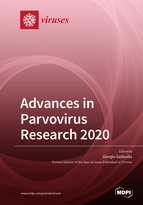Advances in Parvovirus Research 2020
A special issue of Viruses (ISSN 1999-4915). This special issue belongs to the section "Animal Viruses".
Deadline for manuscript submissions: closed (30 June 2021) | Viewed by 60837
Special Issue Editor
Interests: parvovirus B19; virus–cell interactions; viral infections; recombinant viruses; virological diagnosis; antiviral strategies
Special Issues, Collections and Topics in MDPI journals
Special Issue Information
Dear Colleagues,
This Special Issue on ‘Advances in Parvovirus Research 2020’ is associated to the conference “XVIII International Parvovirus Workshop”, meant to take place in Rimini, Italy, in June 2021. The international workshops dedicated to parvoviruses, first held in 1985, are events strictly centred on all aspects of parvovirus research and provide excellent opportunities to focus the research topics in this area.
The aim of this Special Issue of Viruses is to offer an opportunity to collect the newest contributions in the field of parvovirus research. Evolution, structural biology, viral replication, virus–host interaction, pathogenesis and immunity, clinical virology of medical and veterinarian relevance, gene therapy, and viral oncotherapy are a selection of the topics that will be addressed during the conference, as well as being of general interest to a wider audience.
Symposium participants, as well as all researchers working in the field, are cordially invited to contribute original research papers or propose reviews to this Special Issue of Viruses. All participants submitting to this special issue will benefit from a 10% discount for publication fee per article.
Dr. Giorgio Gallinella
Guest Editor
Manuscript Submission Information
Manuscripts should be submitted online at www.mdpi.com by registering and logging in to this website. Once you are registered, click here to go to the submission form. Manuscripts can be submitted until the deadline. All submissions that pass pre-check are peer-reviewed. Accepted papers will be published continuously in the journal (as soon as accepted) and will be listed together on the special issue website. Research articles, review articles as well as short communications are invited. For planned papers, a title and short abstract (about 100 words) can be sent to the Editorial Office for announcement on this website.
Submitted manuscripts should not have been published previously, nor be under consideration for publication elsewhere (except conference proceedings papers). All manuscripts are thoroughly refereed through a single-blind peer-review process. A guide for authors and other relevant information for submission of manuscripts is available on the Instructions for Authors page. Viruses is an international peer-reviewed open access monthly journal published by MDPI.
Please visit the Instructions for Authors page before submitting a manuscript. The Article Processing Charge (APC) for publication in this open access journal is 2600 CHF (Swiss Francs). Submitted papers should be well formatted and use good English. Authors may use MDPI's English editing service prior to publication or during author revisions.
Keywords
- Parvoviridae
- parvovirus evolution
- parvovirus structure
- parvovirus–host interactions
- parvovirus pathogenesis and immunity
- parvovirus oncolytic therapy
- parvovirus vectors
- antiviral strategies
Related Special Issues
- Advances in Parvovirus Research 2022 in Viruses (18 articles)
- New Insights into Parvovirus Research in Viruses (21 articles)
- Advances in Parvovirus Research 2024 in Viruses (3 articles)







